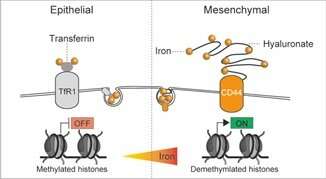Mesenchymal stem cells (on the right) are associated with metastatic dissemination, resistance to conventional chemotherapy and to relapses. During the transition to this state, the protein CD44 takes over from transferrin and its TfR1 receptor and ensures the majority of the iron endocytosis. This leads to a significant increase in cellular ion concentration. In the nucleus, iron operates as a chemical catalyst for oxidative demethylation and "releases" genes whose expression is reprimed by methylated histone proteins, in particular those involved in metastatic dissemination. Accordingly, CD44 regulates the epigenetic plasticity and expression of these genes by iron mediation. Credit: Raphaël Rodriguez/Nature
CNRS researchers at the Institut Curie have recently shown that cancer cells use a membrane protein that has been known for several decades to internalize iron. Published in Nature Chemistry, this work shows that the absorbed iron allows cancer cells to acquire metastatic properties.
Biologists knew CD44 well, but didn't know the major biological function that it fulfills. CD44 is a glycoprotein found on the surface of many cells, in various organs, that is also involved in several biological processes: immune response, inflammation and cancer, among others. For the first time, a research team has shown that it participated in these phenomena by allowing iron to enter cells through endocytosis.
Scientists at the Laboratoire Chimie et Biologie du Cancer (CNRS/INSERM/Institut Curie) and their colleagues reached this conclusion by studying CD44's activity in cancer cells, and the resulting changes to metabolism and genetic expression.
Their results show that CD44 can internalize iron bound to hyaluronic acid. For cancer cells, the iron then fulfills two roles: it supplies the mitochondria so that it can produce metabolites necessary for the cell to pass into a metastatic state and epigenetically unlocks certain genes that are also necessary to the metastatic process. In that state, CD44 even becomes the main pathway for iron to enter cells.
These observations explain why CD44 was already known for its association with the appearance of metastases and relapses. But they are also surprising because until now biologists thought that a different mechanism was involved in iron endocytosis, involving transferrin and its TfR1 receptor. The research team now hopes to develop molecules capable of blocking cellular iron traffic to eliminate cells with high metastatic potential.
More information: CD44 regulates epigenetic plasticity by mediating iron endocytosis, Nature Chemistry (2020). DOI: 10.1038/s41557-020-0513-5. www.nature.com/articles/s41557-020-0513-5
Journal information: Nature Chemistry
Provided by CNRS
























